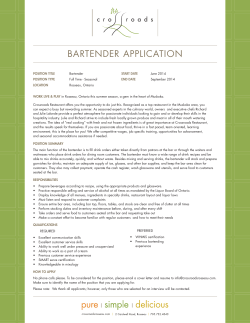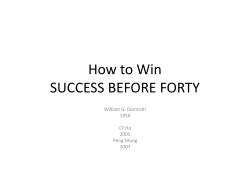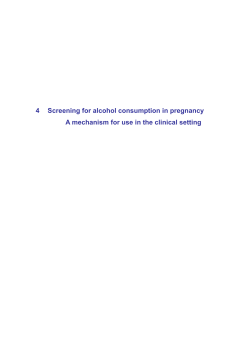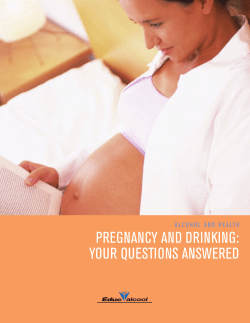
Relaxation (Downer) Drinks What are Relaxation Drinks Missouri’s Youth/Adult Alliance
Relaxation (Downer) Drinks Missouri’s Youth/Adult Alliance What are Relaxation Drinks Relaxation drinks are also known as functional beverages. A functional beverage can be defined as a beverage that satisfies one‟s thirst, contains no alcohol, comes ready to consume, and includes nontraditional ingredients such as vitamins, herbs, minerals, amino acids, etc. Common ingredients in relaxation beverages include: melatonin, valerian root, kava, St. John‟s wort, the amino acid Ltheanine and rose hips. These drinks are often referred to as “downer” or “anti-energy drinks” because of the proclaimed calming effects of the herbs, amino acids, vitamins, etc. that are in the drinks. Currently there are more than 350 kinds of relaxation bever- ages available for purchase to the general public. At least 20 different brands are available for purchase online. Because these beverages are non-alcoholic, there is no age restriction on who can purThe above depicts a select few of the ever growing chase these relaxation beverage market. beverages. Photo from: http://abcnews.go.com/Health/ Relaxation MindMoodNews/relaxation-drinks-sending-wrongbeverages message/story?id=9075829&page=2 have seen an increase in demand due Relaxation drink companies are to worsening economic condiprofiting off of the population‟s tions among other reasons. desire to relax and relieve Consumers of functional beverstress. Relaxation beverages ages are wanting those that tout alone are expected to generate working as mood enhancers more than $500 million in reveand stress relievers. nue over the next year. FDA Classification, Regulation and Health Risks Relaxation drinks are unregulated by the FDA because they are considered a dietary supplement. Therefore, the safety of the products and the ingredients in the drinks are the responsibility of the manufacturer. There are no rules limiting the serving or amount of any particular nutrient in a dietary supplement; this is left to the discretion of the manufacturer and is not reviewed by the FDA for safety. Photo media from: http:/ /mypu rplest uff.c Concerns have been raised regarding the safety of relaxation drinks because some ingredients have not been approved as a food additive, but have been Generally Recognized As Safe (GRAS) by the FDA. (Continued on page 2) om/ FDA Classification, Regulation and Health Risks (continued) Relaxation drinks being unregulated has also sparked concern due to possible interactions between some of the ingredients and not only prescription medications, but natural hormones produced by the body; for example, melatonin. Another health concern that has been raised is the possibility of people using relaxation drinks as a “downer” to help them relax after consuming more than the recommended serving of a caffeinated energy drink. Add alcohol , a “downer,” into the mix, and there is potential for a very dan- gerous combination. A final concern that has been raised, is the potential for confusion with energy drinks due to similar packaging….mistake or intentional? In larger, urban areas, gas station and convenience store clerks have seen an increase in youth ages 18 -24 purchasing relaxation drinks after coming from nightclubs, where alcohol and energy n drinks are a laxatio the re the r o f regular menu d g d in and a ontain epicts ular for c mix. p ge/ hoto d o p evera ow” p bove ood_b The a ge “Slow C nine. /f m o .c a a bever acid, L the pringwise /s amino from: http:/ Photo w/ o slowc Marketing Strategies The United States population has recently seen an increase in dedication to healthy living, and the functional beverage industry is profiting from this. Americans are becoming more aware of natural herbs and vitamins and the potential health benefits from these supplements. With the use of trusted ingredients and “pro-health” wording, relaxation beverages have become a multi-million dollar industry. Probably the most controversial issue surrounding relaxation drinks, is that youth and younger adults may be getting the wrong impression from these drinks. With names like “Mary Jane‟s Relaxing Soda” and “iChill,” and products being marketed in flashy containers and on social networking sites, youth and young adults are being bombarded with messages about alternative ways to cope with stress. “Mary Jane‟s Relaxing Soda” originated from the herb kava being added to a soft Not only have marketing efforts targeted drink and resulting in a audiences and given away free samples of “buzzed” feeling simiThe makers of their products to these audiences, relaxation lar to marijuana, thus beverage companies are using situational the name “Mary Jane.” “Dream Water” target the adult marketing. For example, two relaxation For a young target aubeverages have been formulated to reduce dience this product line population with their stress during air travel and are being marmay come with expec- slogans “drink to dream” and “dream keted to air travelers. tations of marijuana responsibly” being incorporated into Another marketing strategy being used is the product, or feeling the claim that relaxation drinks are an alteras if one had smoked native to having an alcoholic beverage. marijuana. Not to menCompanies are stating their products can be tion, packaging for used not only in the evening and this beverage is Shown above, a picture of Mary Jane’s Relaxing Soda on weekends, but can also be remarkably similar Photo from: http://www.vaporsmagazine.com/2009/08/ used during the day to relax in appearance to a kickback-soda/ and./or to calm down. One could beer bottle. say , instead of learning to cope with stresses in a healthy way, another alternative is being offered. Page 2 Relaxation (Downer) Drinks Controversy Behind Relaxation Drinks Some relaxation drinks have encountered a great deal of scrutiny based on their names. “Drank,” “Sizzyrup,” “Purple Stuff,” “Lean” and “Sippin‟ Syrup” are the top three relaxation drinks facing the most opposition from many communities. With slogans like “slow your roll” and “grip and sip,” “lean with it” and “rock with it” these relaxation drinks have attracted media attention in Texas and among the hip hop community. This potentially deadly mixture when taken in high doses can lead to sleepiness, altered thoughts and impaired motor functions, which can often lead to someone having a “lean” in their walk. Communities are outraged that these relaxation drinks share some of the same street names as the cough syrup mixture. Community leaders, health officials and parents feel as if their youth are being targeted by these relaxation drinks due to the existing knowl/ s/2010 /photo m o c edge of Purple l. lappea mercia m o Drank and fear .c /www : http:/ m o fr that if the Photo 49443/ /1 5 /1 n youth aren‟t ja satisfied with In Texas, the effects of there is an the drink, they epidemic will then turn to the real thing: Purple of mixing Promethazine with codeine Drank. Concerns have also been raised as (prescription cough syrup), 7-UP or Sprite, to whether these relaxation drinks are a and alcohol like gin or vodka; occasionally “gateway drug” for the use of illegal suba Jolly Rancher candy is added to this constances; such as cocoction. Wh deine which is highly e When mixed together, this drink is comdep n con addictive. r ess sum monly referred to as the following: ca e a * Purple Drank * Rainbow Colors * Lean * Sip-Sip * Sizzurp * Syrup * Drank * Purple Jelly * Texas Tea Photo from: http://knowyourmeme.com/ i/7529/original/sizzurp-drank-dat-purplestuff.jpg?1249421355 Rapper Lil Wayne has admitted to consuming purple drank, has made songs about his love for it entitled “Me and My Drank” and has admitted to having associated withdrawal symptoms. Another song about Purple Drank, “Sippin‟ Sizzurp” made popular by the group Three 6 Mafia. The makers of these relaxation drinks maintain that their products are in no way representational of Purple Drank and the resemblances are innocently unintentional and if anything; their products are good for consumers. The CEO of the relaxation drink brand “Drank” stated that the slang term “drank” is common for a party drink. He also stated that to “lean” means to have a relaxed approach to life. d n c a ts (i.e in hig rre hd ., a st due lcoho oses or l) to slo , Purp whe n we d r le Dra mix ed esp nk wit ira ho tor can l ead y fu the r nct to ion . rdi a Hip hop artists such as the late DJ Screw boasted about consuming Purple Drank and unfortunately died due to codeine overdoses as a result of consuming this mixture. Other artists such as Pimp C and Big Moe have boasted about their use of “purple Stuff” and have both died in codeine related overdoses. Page 3 References Frost & Sullivan. (2008, May 29). U.S. functional beverages market: a young market with growing popularity. Flex News. Retrieved from: http://www.flex-news-food.com/console/PageViewer.aspx?page=16777 Gregory, S. (2009, May 18) The anti-redbull: a drink to calm you down. Time.com. Retrieved from: http://www.time.com/time/business/ article/0,8599,1898318,00.html Montgomery, R. (2010, March 15). Missouri health officials concerned by „downer drinks.‟ The Kansas City Star. Retrieved from: http:// www.columbiamissourian.com/stories/2010/03/15/missouri-health-officials-concerned-downer-drinks/ Mui, Y. (2009, August 15). Soft drinks get softer: new niche aims to quench stress. The Washington Post. Retrieved from http:// www.washingtonpost.com/wp-dyn/content/article/2009/08/14/AR2009081403463.html Sober Living by the Sea. (2010, July 27). Purple drank, sippin syrup, sip (promethazine with codeine) fact sheet– ca drug rehab. Retrieved from: http://www.soberliving.com/resources/addictions/purple-drank-sippin-syrup-sip-promethazine-with-codeine-fact-sheet-ca-drug-rehab Noonoo, J. (2008, November 28). Anti-energy drink fuels concern over marketing. Houston Chronicle. Retrieved from http:// www.commercialalert.org/issues/education/soft-drinks/anti-energy-drink-fuels-concerns-over-marketing Reiser, L. (2009, November 16). Drinking to relieve stress: Do relaxation drinks send the wrong message? ABC News. Retrieved from: http://abcnews.go.com/Health/MindMoodNews/relaxation-drinks-sending-wrong-message/story?id=9075829 Rosenbloom, S. (2010, July 2). Skip the scotch, just have a swig of mellowberry. The New York Times. Retrieved from: http:// www.nytimes.com/2010/07/04/fashion/04Noticed.html U.S. Food and Drug Administration. Overview of dietary supplements. Retrieved from: http://www.fda.ove/Food/DietarySupplements/ ConsumerInformation/ucm110417.htm Walker, K. (2010, July 16). Relaxation Nation: Trends in Calming Beverages. Retrieved from: http://www.perfumerflavorist.com/flavor/ trends/98634454.html
© Copyright 2025















